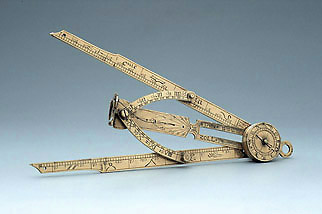
 |
| Catalogue |
 |
 Gunner's Compendium The main legs are shaped so that they narrow to a point; each has a hole near the endpoint and beside the joint. On their faces they carry a calendar-zodiac scale. The zodiac runs across the upper faces, each sign represented by its symbol, divided to 10 and 2 and numbered by 10. The calendar is on the underside with each month divided to 10 and 2 days, with alternate cross-hatching of the intervals. The calendar scale has some idiosyncratic spelling ('VEBRVARI', 'APERILIS', 'SEPTEMER') and, although the number of days in the month is usually given in numbers, all the months are actually divided into 30. Further numerical information appears in each month along with the explanatory inscription running from February to May 'DAG LENG VND NACH LEN'. However, the numbers do not represent the lengths of day and night; rather they give a value for the length of the day and the time of sunrise and sunset for each day. From January to June the length of the day is shown as increasing from 9 to 14 hours by one hour each month. The information for the second half of the year on the other leg is partly garbled. Also problematic is table's implication that the equinoxes take place in April and October, and that the summer solstice is in July. On the joint of the these two legs is a compass box 25 mm in diameter. In the bowl of the box is a scale of equal parts 1 to 12, divided to 1, 1/2 and 1/4 and numbered by 1. The compass has a brass cover with the same scale and a movable index pointer. The instrument is also intended to serve as direct-reading calipers, providing the same measures as a gunner's gauge. As the opening of the two main legs is adjusted the joint and the compass move in the slot in the central third leg. The compass's edge cuts two scales on the upper side of the leg, one for 'ZOLL' from 3 to 9 giving the separation of the points in inches and the other for 'STAIN' giving the weight of a measured stone sphere from 5 to 37 (with two divisions for 46 and 50 apparently in a smaller unit). On the underside, the edge of the joint cuts two further scales, of 'PLEY' for lead spheres from 1 to 100 and 'EISEN' for iron from 1 to 95. At the origin of the scales on the underside is the date 1595 beside a suspension ring. It is not clear whether these scales would have worked. While the inch scale provides answers readily enough, the other gauge scales are less straightforward and without units of weight they cannot be verified. Certainly, the instrument cannot take the diameters of spherical shot as the scales might appear to suggest. The instrument incorporates a horizontal string gnomon dial with a scale of hours on the upper side of the central leg and a hinged gnomon support at its end. The hour scale is centred on a hole in the leg and runs from 8 to 12 to 4, with additional unnumbered lines for 7 and 5. Beside this origin point is a monogram 'MH' or 'HM', perhaps standing for a combination of 'hora' and 'meridies', or possibly for the maker. The string is easily inserted and removed from the top most hole in a sliding section of the hinged support. The sliding section can be adjusted for latitude against a scale on which only 48 is numbered; the indicator which moves against the scale is marked 'POL'. On the other side of the support is a line marked 49 against which the circular end of the sliding section can be set, presumably for 49? latitude. The sliding section of the gnomon support has four additional holes numbered 1 to 4. There are also seven additional holes on the central leg which, together with the origin hole for the hour scale, form part of a scale on the underside 1 to 8, divided to 1, 1/2 and 1/4. It has been thought that these holes are all meant to be used as part of the sundial, to accommodate different latitudes. However, only one hole on the leg can be used with the hour lines, and the slider on the hinged upright provides the necessary range of latitudes. It seems more plausible that the holes were intended as gunner's sights; certainly they closely resemble other gunner's instruments with fixed hole sights. The two arcs linking the main legs with the central leg also carry scales and are evidently intended to be used only when the main legs are perpendicular to each other at their maximum extent. Their upper faces carry a quadrant scale of degrees divided to 10 and 2 and numbered by 10. From 10 to 80?, each of the main divisions also has a Roman numeral VIII to XII to IIII, presumably representing hours. However, with a scale of equal parts and 10? to the hour, the possible purpose of the scale is unclear. On the underside of the linking arms is a shadow square 'VMRA VESA' and 'VMRA RECDA' from 0 to 12 to 0, divided to 2, 1 and 1/2 and numbered by 2. The central leg is scolloped to accommodate the fixtures for the linking arcs, so that the instrument can be folded shut. Despite its unusual form and its many problems of form and function, there is at least on other instrument of the same general type, by Erasmus Habermel. See: J. Bennett and S. Johnston, The Geometry of War, 1500-1750 (Oxford, 1996), p. 25. Stephen Johnston |



